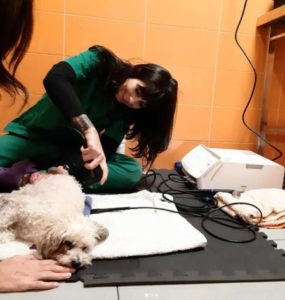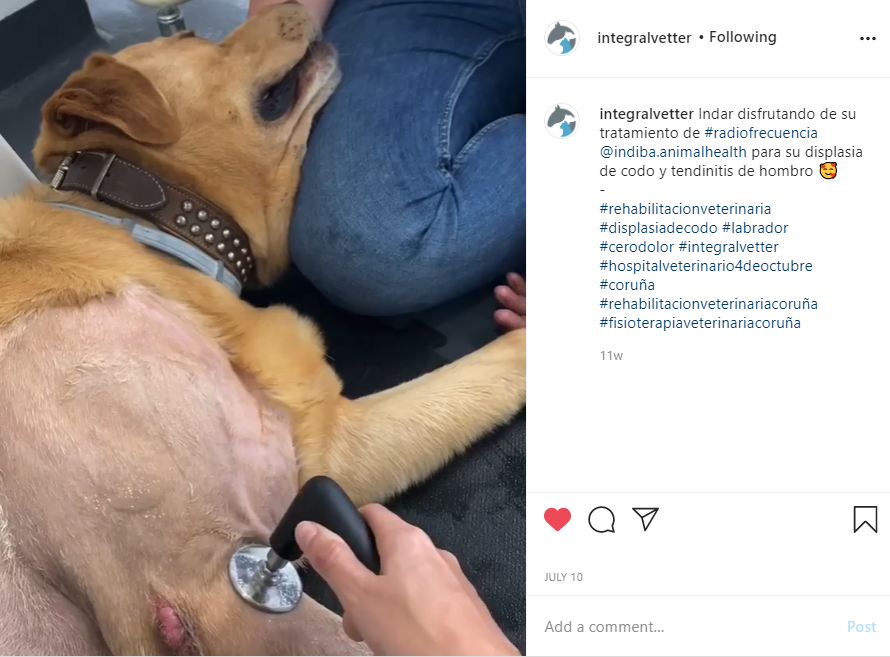Interview with: Nuria Otero (Spain)
Published:30 September,2020
A couple months ago, we had the opportunity to interview Nuria Otero, a veterinarian and rehabilitation and sports medicine specialist, head of the rehabilitation service at Hospital Veterinario 4 de Octubre (A Coruña, Spain).
In November 2019, Nuria started using the AH-100, our device for small animals, and we wanted to know how her experience has been so far and this is what she told us:
Did you know about radiofrequency before trying INDIBA?
A: Yes, I knew it as a patient and was surprised by the result. I also came across it by reading up-to-date articles related to veterinary rehabilitation and attending conferences.
How did you find out about INDIBA Animal Health?
A: It was introduced to me by other veterinary colleagues who specialize in rehabilitation and I verified its effects with Michela Arena (FisioDog) at the XV ISDVMA Conference in Valencia, where she conducted a workshop demonstration. Of course, I volunteered for a mini-session!
In which cases have you applied INDIBA?
A: I use it a lot; alone or in combination with other therapies, in order to benefit from its synergies. Joint pathologies, such as elbow or hip dysplasia, post-surgical treatments, neuropathic pain, osteoarthritis, tendinopathies, intervertebral disc disease, muscle contractures, spasticity… the list is very extensive.
What is the most relevant effect you have obtained in your treatments? In which patients / pathologies have the results of the treatments been most striking / significant?
A: Control of pain and inflammation is surprisingly fast. In post-surgical and trauma patients, I start treatments immediately. When applied to edema, bruising and inflammation, there is a remarkable change observed in the before and after comparison, in addition to this, it significantly shortens recovery times. In the control of neuropathic pain, normally so difficult to manage, INDIBA has proven its effectiveness for me, as well as in the treatment of tendinopathies or muscular pathologies.
As you well know, INDIBA is a tool that creates synergies when combined with other techniques. Has the situation arisen that allowed for a combination of INDIBA with techniques such as hydrotherapy, mobilizations, exercises, etc.?
A: I always combine therapies if it is indicated for the patient. Specifically, the combination of INDIBA treatment and passive mobilizations makes for a much more effective and comfortable treatment, just like joint or spinal manipulation (chiropractic). The hydrotherapy-INDIBA tandem is already a classic in our sessions, as well as a pre-treatment application before, for example, a spinal traction treatment.
Do you find marked differences between treatment with INDIBA and treatment with other physical therapies? If so, can you tell us what are the differences that you find?
A: I would highlight the versatility and treatment times. We can treat many different pathologies in a relatively short time and with results that appear almost immediately.
It is very important to bear in mind that with INDIBA we can treat cancer patients safely in this regard. Our dogs and cats live increasingly longer to reach advanced ages, in which the appearance of neoplasms is not uncommon. It is a comfort to know that we can treat them without harmful effects.
Finally, about the treatment itself with INDIBA, what do you think?
A: Treatment with INDIBA is comfortable and pleasant for all patients. As it is not uncomfortable or invasive and does not involve immobility or postures maintained for a long time, it is very well tolerated by the patient, even by the most nervous or sensitive patient.
Aknowledgements:
Hospital Veterinario 4 de Octubre
Want to try INDIBA at your clinic?
Contact us
